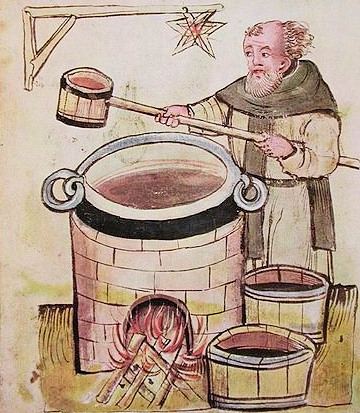Medieval English Ale

In medieval England virtually everyone would have drunk ale on a daily basis. That’s not to imply that the whole population was constantly inebriated. The fact is medieval ale was a very different drink to any modern-day beer or ale. The basic ingredients were water and malted grain fermented with yeast (beer as oppose to ale also included hops as an ingredient). Ale was both used for hydration and nutrition and was very much an essential part of the English diet. This was a time when most people rarely drank water or milk. Although the wealthier could also afford to drink wine, ale was the overwhelming liquid refreshment of choice for much of the population. Then as now people could drink to get merry, to get drunk even, but it was also a much more mundane, day to day experience. Both children and adults drank ale, it was consumed throughout the day.
The basic ale making process consisted of the malted grain being crushed, boiling or very hot water would be added, and the mixture allowed to work. The liquid would then be drained off, cooled and fermented.
Although a relatively simple process it was also time consuming. In medieval England this type of ale would be served fresh which means it had very recently stopped fermenting or it was still in the process of fermenting. Ale did not keep well, being fast to sour and lasting at most only a few days.
The amount of ale that was brewed and consumed appears enormous to modern day eyes. For a household of five perhaps up to one and quarter gallons would be required per day.
During the fourteenth century most of the ale brewing in England was carried out by women in a domestic setting. Most households had the capability to brew ale for their own use and sometimes to sell to others. For many households it could be a valuable source of extra income even if they only sold to others a few times a year. When a fresh brew was available for others to buy a sign would be hung outside, often a broom.